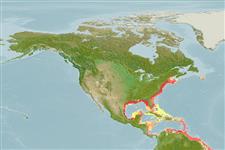Common names from other countries
Environment: milieu / climate zone / depth range / distribution range
Écologie
Pélagique; profondeur 0 - 85 m (Ref. 116114). Subtropical
Distribution
Pays | Zones FAO | Écosystèmes | Occurrences | Introductions
Western Atlantic: USA and Canada.
Length at first maturity / Taille / Poids / Âge
Maturity: Lm ? range ? - ? cm Max length : 35.0 cm WD mâle / non sexé; (Ref. 2992)
Description synthétique
Morphologie
35 m wide, thick and rigid; centre of exumbrella smooth, lappets with many shallow furrows, and near margin numerous minute elevations; in each octant 6 large oval velar lappets mouth arms with 26 to 60 blunt, spindle-shaped appendages besprinkled with nematocyst warts, each arm with a large, tapering terminal appendage.
Estuarine, neritic, potentially pathogenic (Ref. 116114).
Life cycle and mating behavior
Maturité | Reproduction | Frai | Œufs | Fécondité | Larves
Members of the class Scyphozoa are gonochoric. Life cycle: Egg is laid by the adult medusa which later develops into a free-living planula, then to a scyphistoma to a strobila, and lastly to a free-living young medusa.
Cairns, S.D., D.R. Calder, A. Brinckmann-Voss, C.B. Castro, D.G. Fautin, P.R. Pugh, C.E. Mills, W.C. Jaap, M.N. Arai, S.H.D. Haddock and D.M. Opresko. 2003. (Ref. 1663)
Statut dans la liste rouge de l'IUCN (Ref. 130435)
statut CITES (Ref. 108899)
Not Evaluated
Not Evaluated
Menace pour l'homme
Harmless
Utilisations par l'homme
| FishSource |
Outils
Plus d'informations
Taille/ÂgeCroissanceLongueur-poidsLongueur-longueurMorphologieLarvesAbondance
Sources Internet
Estimates based on models
Vulnérabilité
Low vulnerability (25 of 100).
Catégorie de prix
Unknown.
